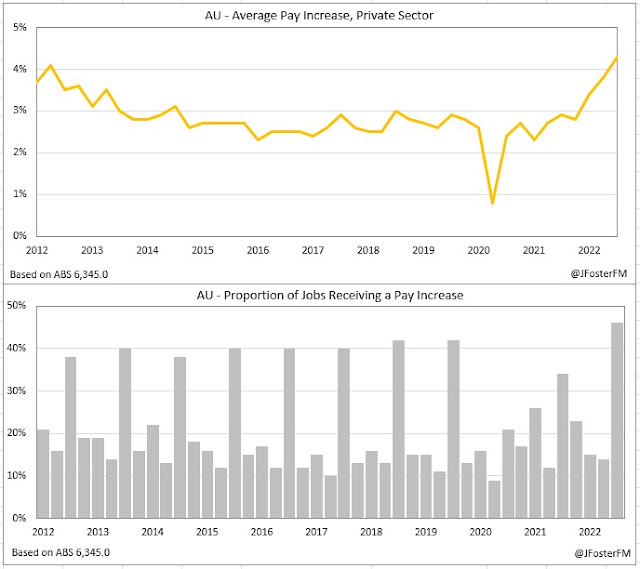Australian wages growth has lifted above a 3% annual pace for the first time since 2013, boosted in the September quarter by private sector wage reviews and increases to the national minimum wage and award rates. Labour costs have risen as the labour market has tightened coming out of the pandemic, but Australian inflation remains more driven by pandemic-related and global supply factors.
Wage Price Index — Q3 | By the numbers
- The headline WPI (total hourly rates of pay ex-bonuses) lifted by 1% in the September quarter, higher than the 0.9% rise expected and up from Q2's 0.8% increase. Annual wages growth advanced from 2.6% to 3.1%, a 9½-year high.
- Private sector WPI lifted by 1.2%q/q (prior: 0.8%), its fastest quarterly rise since Q2 2008, lifting to be 3.4% higher through the year (from 2.6%).
- Wages growth in the public sector was unchanged from the June quarter at 0.6%q/q and 2.4%Y/Y.
Wage Price Index — Q3 | The details
In the private sector, wages growth accelerated by 1.2% in the quarter, elevating the annual pace to 3.4% - a near decade high. Outside of the Covid period, annual wage reviews in Australia typically take place in Q3 at the start of the financial year. Given the significant strength in the labour market and the high prevalence of jobs in the sector covered by individual agreements, annual wage reviews were the driving factor in the acceleration in wages growth in Q3.
The ABS's analysis found that 46% of private sector jobs received pay increases in the September quarter - higher than the usual share at this time of the year, at around 40%. Pay increases to the jobs that received them averaged 4.3%; the last instance where the average increase was above 4% was back in 2012. The rising momentum in wages growth reflects the responsiveness of the private sector to the strength in underlying labour market conditions, which have continued to tighten post the recovery from the pandemic crisis.
In addition to rising base wages, firms have also increasingly relied on bonus payments to retain and attract staff, or in the absence of that have offered one-off payments for the higher cost of living. Reflecting this, the private sector WPI inclusive of bonuses measure posted its strongest quarterly increase in 11 years (1.6%) to be up through 4% over the year.
Public sector wages growth held steady for the third quarter running at 0.6%, leaving the annual pace firmly contained at 2.4%, in line with its pre-pandemic range. Wage policies of governments at the federal and state levels have sought to limit growth in labour costs through wage caps; however, these policies have increasingly come under review and have been recalibrated in response to the acceleration in inflation, which will take time to flow through to the data.
From an industry perspective, wages growth in the goods-related and business services sectors is running at its strongest pace since 2012 at around 3.5%. Wages growth in household services is lagging at 2.8%, though some of the industries in this sector have yet to see the announced award rate increase come through, with the Fair Work Commission delaying the increase for pandemic-affected industries until Q4.
In the goods-related sector, wages growth picked up sharply in the retail sector to be running at 4.2%Y/Y, boosted by the increases to award rates. Labour shortages have impacted many industries in the sector, pushing up wages growth in the construction (3.4%) industry in particular.
For business services, wages growth has picked up across the sector to its fastest pace in around 10 years amid strong competition for labour.
Wages growth has been less responsive in household services to the tightening in the labour market, in part because of its larger share of public sector jobs, in particular in health care and education. Also, as alluded to earlier, the award rate increase in the accommodation and food services industry has yet to fully come through. This sector does, however, have one industry where wages growth is running above 4%: rental, hiring and real estate, coming on the back of strong demand for those services.
Wage Price Index — Q3 | Insights
Australian wages growth is running with a 3-handle for the first time since early 2013, responding to the tightening that has occured in the labour market following the recovery from the pandemic. High inflation has led to upward pressure on national settings for the minimum wage and awards also boosting wages growth, though households continue to face falling real incomes regardless. Today's outcome was a little stronger than expected but is broadly in line with RBA projections for wages growth. Overall, Australian inflation is in the main being driven by pandemic and global supply-related factors rather than domestic wage pressures.















